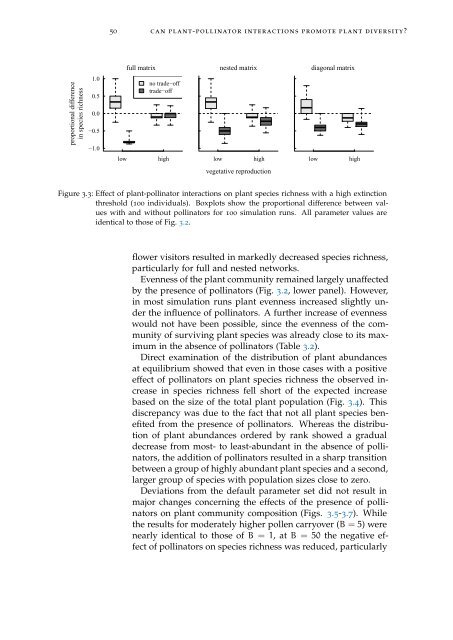Linking Specialisation and Stability of Plant ... - OPUS Würzburg
Linking Specialisation and Stability of Plant ... - OPUS Würzburg
Linking Specialisation and Stability of Plant ... - OPUS Würzburg
Create successful ePaper yourself
Turn your PDF publications into a flip-book with our unique Google optimized e-Paper software.
50 can plant-pollinator interactions promote plant diversity?<br />
proportional difference<br />
in species richness<br />
1.0<br />
0.5<br />
0.0<br />
−0.5<br />
−1.0<br />
low<br />
full matrix nested matrix diagonal matrix<br />
no trade−<strong>of</strong>f<br />
trade−<strong>of</strong>f<br />
high<br />
low high low high<br />
vegetative reproduction<br />
Figure 3.3: Effect <strong>of</strong> plant-pollinator interactions on plant species richness with a high extinction<br />
threshold (100 individuals). Boxplots show the proportional difference between values<br />
with <strong>and</strong> without pollinators for 100 simulation runs. All parameter values are<br />
identical to those <strong>of</strong> Fig. 3.2.<br />
flower visitors resulted in markedly decreased species richness,<br />
particularly for full <strong>and</strong> nested networks.<br />
Evenness <strong>of</strong> the plant community remained largely unaffected<br />
by the presence <strong>of</strong> pollinators (Fig. 3.2, lower panel). However,<br />
in most simulation runs plant evenness increased slightly under<br />
the influence <strong>of</strong> pollinators. A further increase <strong>of</strong> evenness<br />
would not have been possible, since the evenness <strong>of</strong> the community<br />
<strong>of</strong> surviving plant species was already close to its maximum<br />
in the absence <strong>of</strong> pollinators (Table 3.2).<br />
Direct examination <strong>of</strong> the distribution <strong>of</strong> plant abundances<br />
at equilibrium showed that even in those cases with a positive<br />
effect <strong>of</strong> pollinators on plant species richness the observed increase<br />
in species richness fell short <strong>of</strong> the expected increase<br />
based on the size <strong>of</strong> the total plant population (Fig. 3.4). This<br />
discrepancy was due to the fact that not all plant species benefited<br />
from the presence <strong>of</strong> pollinators. Whereas the distribution<br />
<strong>of</strong> plant abundances ordered by rank showed a gradual<br />
decrease from most- to least-abundant in the absence <strong>of</strong> pollinators,<br />
the addition <strong>of</strong> pollinators resulted in a sharp transition<br />
between a group <strong>of</strong> highly abundant plant species <strong>and</strong> a second,<br />
larger group <strong>of</strong> species with population sizes close to zero.<br />
Deviations from the default parameter set did not result in<br />
major changes concerning the effects <strong>of</strong> the presence <strong>of</strong> pollinators<br />
on plant community composition (Figs. 3.5-3.7). While<br />
the results for moderately higher pollen carryover (B = 5) were<br />
nearly identical to those <strong>of</strong> B = 1, at B = 50 the negative effect<br />
<strong>of</strong> pollinators on species richness was reduced, particularly
















